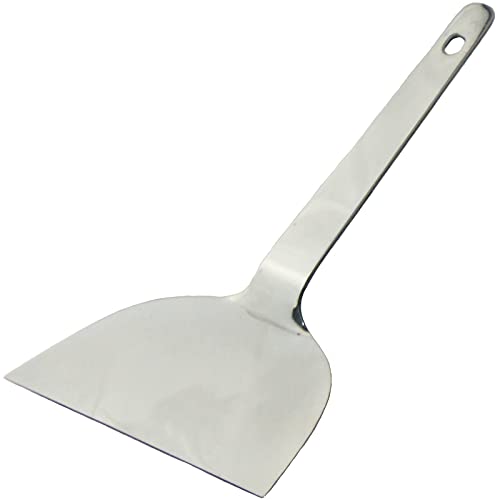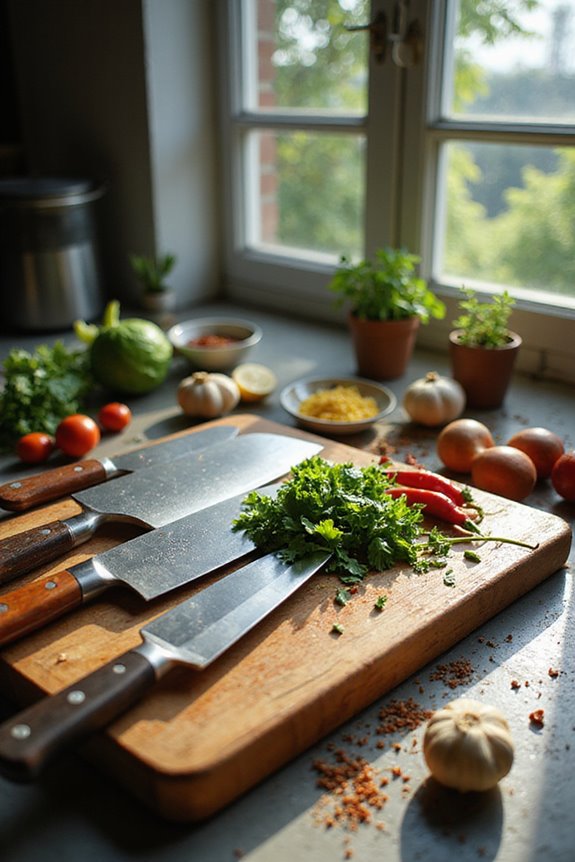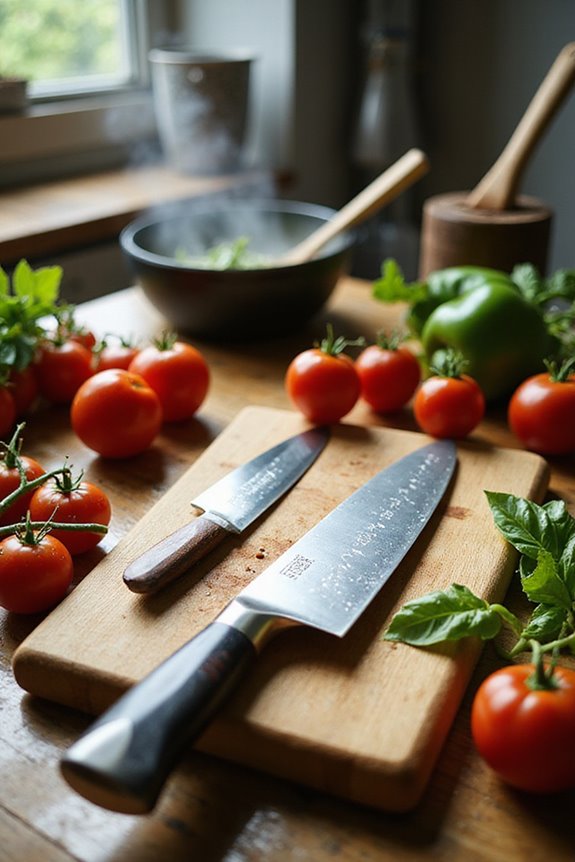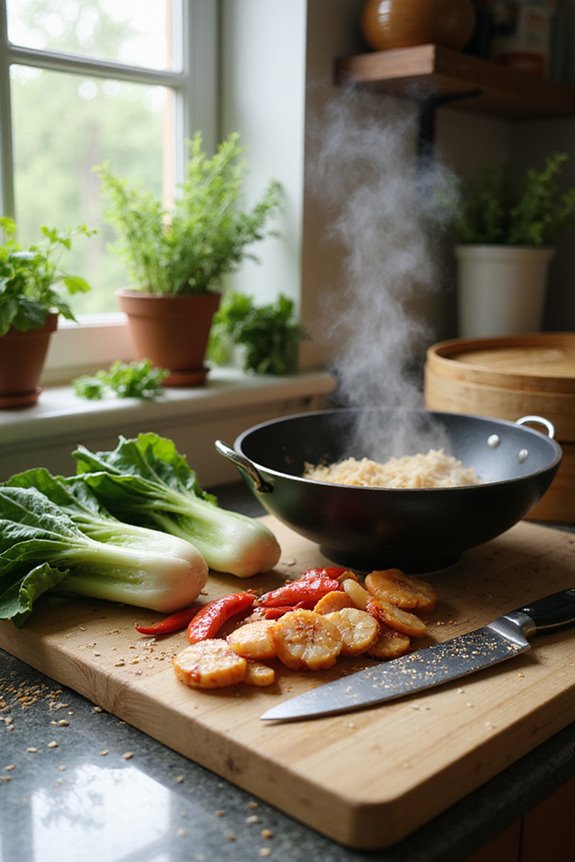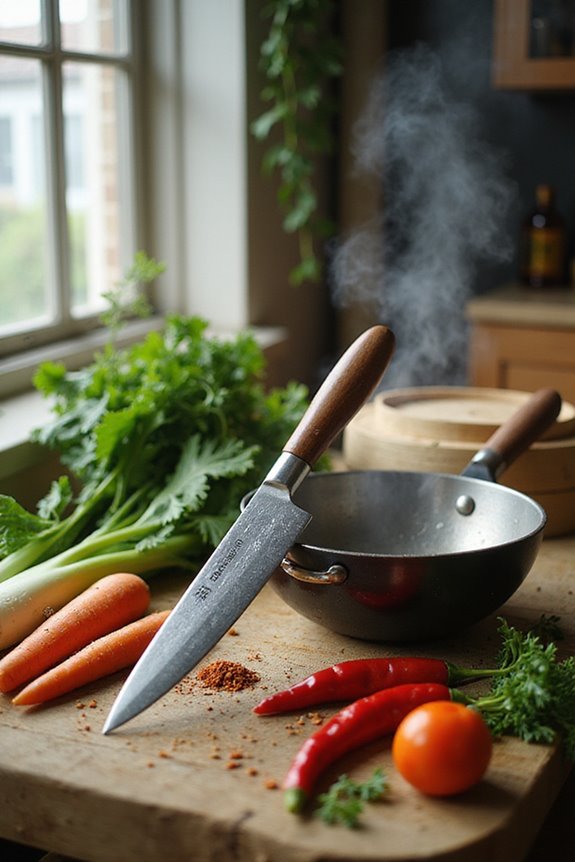As an Amazon Associate, we earn from qualifying purchases. Some links may be affiliate links at no extra cost to you. Although our opinions are based on curated research, we haven't used these products. Articles generated with AI.
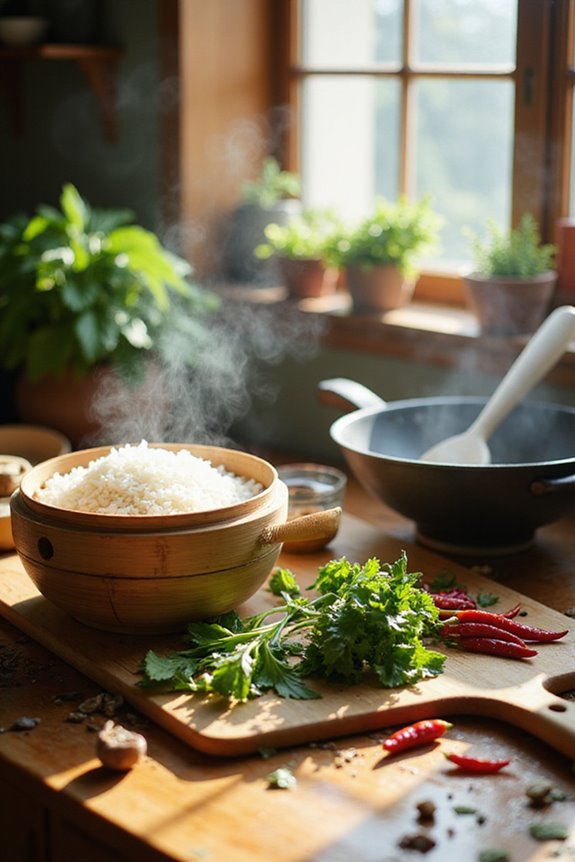
5 Best Traditional Asian Kitchen Implements That Every Home Cook Should Own
To elevate your cooking game, every home cook should own a Chinese Chef Knife Vegetable Cleaver, renowned for its sharpness and efficiency. Pair it with a Tsubamesanjo Okonomiyaki Spatula made from durable stainless steel for superior flipping. Don’t forget the Helen’s Asian Kitchen Bamboo Kitchen Spoon for stirring, and the Joyce Chen Burnished Bamboo Angled Spatula to protect your non-stick surfaces. Finally, a Damascus Nakiri Knife offers fantastic precision. Explore more tools for every culinary task!
Key Takeaways
- Chinese Chef Knife: An essential tool for slicing and dicing, this 8-inch knife offers sharpness and efficiency with its ergonomic walnut handle.
- Damascus Nakiri Knife: Known for its impressive hardness and precision, this 6.5-inch knife excels at vegetable preparation with its hand-sharpened blade.
- Okonomiyaki Spatula: A versatile spatula made of durable stainless steel, perfect for flipping and serving various dishes while providing excellent control.
- Bamboo Kitchen Spoon: This eco-friendly and lightweight spoon is ideal for stirring and mixing, minimizing stain absorption and odors in your kitchen.
- Burnished Bamboo Angled Spatula: Protecting non-stick cookware, this 14-inch spatula is not only lightweight but also dishwasher safe for easy cleaning.
Helens Asian Kitchen Chinese Chef Knife Vegetable Cleaver
Helen's Asian Kitchen Chinese Chef Knife Vegetable Cleaver, Japanese Carbon Steel, 8-Inch Blade
- Helen Chen’s Asian Kitchen 8-inch Chinese Chef Knife slices, dices, and minces vegetables and boneless meats
- Made from high-quality Japanese carbon steel and walnut handle; measures 12 x 3.25 x 1.25 with 8-inch blade
- Long-lasting, razor-sharp cutting edge; blade can easily be resharpened if it ever becomes dull from use
If you’re someone who enjoys cooking with precision and flair, the Helen Chen’s Asian Kitchen Chinese Chef Knife Vegetable Cleaver is an excellent choice for you. This 8-inch knife, crafted from high-quality Japanese carbon steel, excels at slicing, dicing, and mincing both vegetables and boneless meats. Its ergonomic walnut handle guarantees a comfortable grip during extended use. The razor-sharp edge maintains its cutting performance, but be sure to hand wash and dry it thoroughly to preserve its quality. With an average rating of 4.2 stars, many users appreciate its sharpness and efficiency—just remember to handle it with care to avoid accidental cuts!
Best For: Home cooks and culinary enthusiasts looking for a versatile and sharp knife to enhance their food preparation experience.
Pros:
- High-quality Japanese carbon steel blade maintains a long-lasting, razor-sharp edge for efficient cutting.
- Ergonomic walnut handle provides a comfortable grip, minimizing hand fatigue during prolonged use.
- Limited lifetime warranty offers peace of mind regarding the knife’s durability and performance.
Cons:
- Requires hand washing to maintain quality; not dishwasher safe, which may be inconvenient for some users.
- Some users reported sharp edges on the top of the blade causing accidental cuts during use.
- Regular sharpening and maintenance are necessary to keep the knife performing optimally.
Tsubamesanjo Okonomiyaki Spatula (4.7 inches, Stainless Steel)
Nagao Tsubamesanjo Okonomiyaki Spatula, Width 4.7 inches (12 cm), Stainless Steel Pattern, Made in...
- Size: Total length 7.0 x width 2.5 inches (178 x
- Material: Stainless steel
- Country of Origin: Japan/Tsubame Sanjo
For anyone serious about grilling or teppanyaki cooking, the Tsubamesanjo Okonomiyaki Spatula stands out as an essential tool in the kitchen. This commercial-grade spatula measures 4.7 inches, designed from solid stainless steel for durability. Weighing just 1.4 ounces, it’s lightweight yet sturdy, making flipping and serving easy. The rectangular shape and 2.5-inch width provide ideal control, whether you’re cooking okonomiyaki or baked mongja. While the spatula isn’t dishwasher safe, its minimalist packaging reflects a thoughtful approach to waste reduction. With a solid average rating of 4.4 stars, chefs appreciate its quality, though some suggest a longer handle for better maneuverability.
Best For: The Tsubamesanjo Okonomiyaki Spatula is best for serious grillers and teppanyaki chefs who value quality and durability in their kitchen tools.
Pros:
- High-quality stainless steel construction for long-lasting use.
- Lightweight design allows for easy handling and maneuvering.
- Rectangular shape provides excellent control for flipping and serving.
Cons:
- Not dishwasher safe, requiring hand washing.
- Some users find the handle length inadequate for better grip.
- Minimal packaging may lack detailed instructions for use.
Helen’s Asian Kitchen Bamboo Kitchen Spoon Cooking Utensil, 12-Inch
Helen’s Asian Kitchen Bamboo Kitchen Spoon Cooking Utensil, 12-Inch
- Helen’s Asian Kitchen Natural Bamboo Spoon for stirring, mixing, dividing, tasting, turning, and serving foods
- Made from 100-percent natural bamboo; fast-growing, fully sustainable alternative to traditional materials for a more sustainable living
- Lightweight, strong, less absorbent than wood
Helen’s Asian Kitchen Bamboo Kitchen Spoon Cooking Utensil stands out as an excellent choice for those who appreciate versatility in their kitchen tools. This 12-inch spoon is lightweight yet strong, making it perfect for stirring, mixing, and serving a variety of dishes. Crafted from 100% natural bamboo, it’s eco-friendly and less absorbent, minimizing stains and odors. You’ll find it easy to store, fitting neatly in drawers or utensil holders. While hand washing is necessary to maintain its appearance, users praise its durability and comfort. Keep in mind some may experience size variations, but overall, it’s a fantastic addition to any home cook’s arsenal.
Best For: Home cooks, families, and novice chefs looking for a versatile and eco-friendly kitchen utensil.
Pros:
- Lightweight and strong, making it easy to handle and perfect for various cooking tasks.
- Made from sustainably sourced bamboo, minimizing environmental impact and reducing staining and odors.
- Fits conveniently in kitchen drawers and looks attractive in utensil holders.
Cons:
- Some users reported receiving smaller sizes than advertised (10-inch instead of 12-inch).
- The finish may be rough for some, requiring additional sanding for comfort before first use.
- Concerns about longevity, with a few users mentioning durability issues over time.
Joyce Chen Burnished Bamboo Angled Spatula (14-inch)
Sale
Joyce Chen a Division of Columbian Home Products Joyce Chen 33-2048 Burnished Bamboo Angled Spatula,...
- No stain or paint used
- Made of bamboo
- Will not scratch non-stick cookware
Elevating your stir-fry game, the Joyce Chen Burnished Bamboo Angled Spatula (14-inch) is perfect for home cooks who appreciate the balance of function and style in their kitchen tools. Crafted from natural bamboo, this spatula won’t stain or scratch your non-stick cookware. Its burnished finish guarantees a smooth feel while effectively tossing and flipping food. Weighing just 0.1 pounds, it’s lightweight and easy to handle. Plus, the 14-inch length provides a comfortable distance from heat, giving you excellent control. It’s dishwasher safe for effortless cleaning, making it an essential implement for anyone who loves to stir-fry or sauté.
Best For: Home cooks who want an effective and stylish tool for stir-frying and sautéing without damaging their cookware.
Pros:
- Made from natural bamboo, ensuring no staining or scratching of non-stick surfaces.
- Lightweight design allows for easy handling and control while cooking.
- Dishwasher safe for easy cleaning and maintenance.
Cons:
- Some users have reported build quality issues, including rough areas or defects.
- Limited heat resistance compared to metal spatulas, which may not be suitable for very high-temperature cooking.
- Not ideal for heavy-duty tasks, as it may bend or break under significant pressure.
Damascus Nakiri Knife 6.5 Inch, VG-10 Japanese Kitchen Knife
Sale
HOSHANHO Damascus Nakiri Knife 6.5 Inch, Super Sharp Damascus 10Cr15CoMoV Japanese Kitchen Knife,...
- DAMASCUS SUPER STEEL CORE - Nakiri knife is made of Japanese 10Cr15CoMoV steel core, which is hammered by vacuum heat treatment. During folding and forging process, it...
- HANDMADE WATER-SHARPENED BLADE - Japanese kitchen Knife are sharpened by hand using the power of a sharpening stone and the flexibility of water, sand and cleaning...
- ERGONOMIC COMFORTABLE WOOD HANDLE - Damascus cooking knife with ergonomic olive wood handle retain the utmost comfort and control with the hand-polished, kitchen knife...
The Damascus Nakiri Knife 6.5 Inch, crafted by HOSHANHO, is an excellent choice for home chefs who value precision and performance in their kitchen tools. With its VG-10 steel core, this knife boasts impressive hardness, ensuring a razor-sharp edge. Its hand-sharpened, 15-degree blade reduces friction thanks to an anti-stick design, making vegetable prep smoother. Weighing 13.7 ounces, it’s well-balanced with an ergonomic olive wood handle that offers comfort during extended use. Whether you’re slicing vegetables or trimming meats, this versatile cleaver excels. Just remember, its sharpness demands careful handling, so always approach with caution to prevent mishaps in the kitchen!
Best For: Home chefs and cooking enthusiasts seeking a high-quality, versatile knife for precision vegetable and meat preparation.
Pros:
- Hand-sharpened 15-degree edge for exceptional sharpness and performance.
- Ergonomic olive wood handle providing comfort and stability during use.
- Anti-stick design with unique grooves to minimize food sticking and reduce friction.
Cons:
- Must be handled with care due to extreme sharpness, which can pose safety risks.
- Some customers express concerns about the knife being made in China despite using Japanese steel.
- Limited warranty information may leave some users cautious about long-term use.
Factors to Consider When Choosing Traditional Asian Kitchen Implements
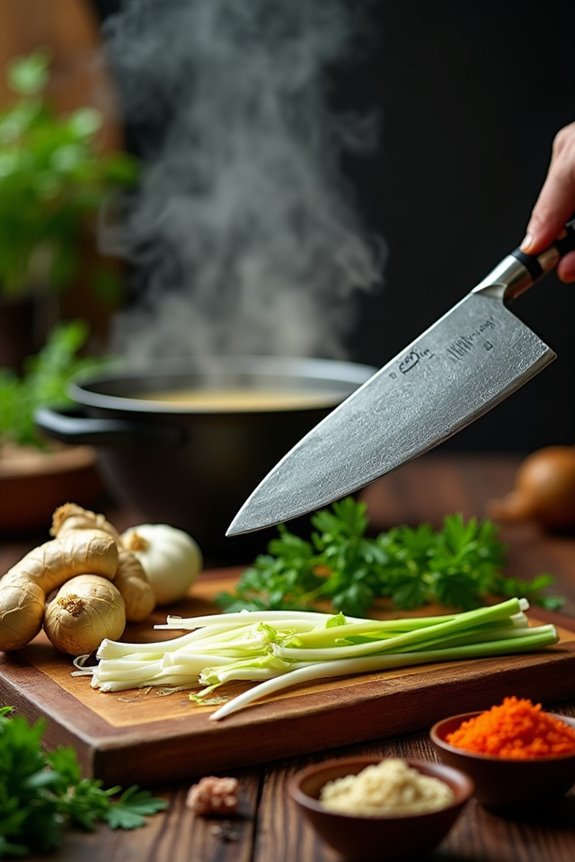
When choosing traditional Asian kitchen implements, you should consider several important factors to guarantee they meet your cooking needs. Focus on material quality, as this affects durability and performance, and pay attention to blade designs that suit specific tasks. Don’t forget to evaluate handle comfort for ease of use and maintenance requirements to keep your tools in top shape.
Material Quality Considerations
Choosing the right materials for traditional Asian kitchen implements is essential if you want to enhance your cooking experience. High-quality carbon steel knives, like those made from VG-10, provide excellent hardness and a razor-sharp edge, which are crucial for precise cutting tasks. For utensils, consider natural bamboo, as it’s lightweight, sustainable, and less absorbent than wood, reducing stains and odors. Don’t overlook ergonomic handle designs—often crafted from walnut or olive wood—that improve comfort and control during intricate tasks. Finally, the construction method matters; forged tools tend to offer superior balance and durability compared to stamped ones. By prioritizing material quality, you’ll invest in tools that greatly elevate your cooking.
Blade Design Variations
Building on the importance of quality materials in traditional Asian kitchen implements, understanding blade design variations is key to finding the right tools for your cooking style. Traditional Asian knives, like the Nakiri or Chinese Chef Knife, feature straight edges that excel at slicing and mincing vegetables and boneless meats. Pay attention to blade material—high-carbon steel offers sharpness and durability, while stainless steel provides corrosion resistance. The thickness of the blade matters too; thicker blades add stability for chopping, while thinner blades allow for precision in intricate cuts. Finally, consider unique designs, such as anti-stick grooves, which enhance cutting efficiency, making your food prep smoother and more enjoyable. Choose wisely to elevate your culinary experience!
Handle Comfort Features
Finding a kitchen implement that feels comfortable in your hand is vital for enhancing your cooking experience. The handle material plays an important role; bamboo and walnut provide a lightweight, sturdy grip that minimizes hand fatigue. Ergonomic designs improve your grip and control, essential for precision tasks in Asian cooking techniques. Balance also matters; a handle’s weight needs to complement the blade for stability and ease of use. Consider the grip’s texture; textured surfaces can prevent slipping, especially with wet ingredients. Finally, think about length variations—longer handles offer better leverage for larger tasks, while shorter ones enhance control for intricate methods. Choosing the right handle contributes greatly to your overall cooking efficiency and enjoyment.
Maintenance and Care
When choosing traditional Asian kitchen implements, proper maintenance and care greatly impact their longevity and performance. Always hand wash your knives and utensils made from carbon steel and bamboo, and make certain to dry them thoroughly. Regular sharpening is essential for cutting tools, while wooden handles benefit from wood preservative applications. To keep bamboo utensils in top shape, use them wisely and apply mineral oil to prevent staining; avoid soaking them in water for long periods. Dishwashers can ruin your tools, so stick to gentle hand cleaning. Finally, store your knives in sheaths or blocks, and keep utensils in drawers or holders to maintain their condition and guarantee safety when they’re not in use.
Versatility for Tasks
Choosing the right traditional Asian kitchen implements can greatly enhance your cooking experience, especially when you consider their versatility for various tasks. Tools like knives and spatulas are designed for multiple functions, such as slicing, dicing, stirring, and flipping. Their ergonomic design makes them comfortable to handle, even during long cooking sessions, allowing for efficient task execution. Many implements are made from materials suited for specific techniques—bamboo utensils are gentle on non-stick cookware, while forged knives offer superior cutting performance. By opting for versatile tools, you can simplify storage, which is especially beneficial in small kitchens. Quality traditional implements balance functionality and durability, ensuring they stand up to frequent use while excelling in various culinary tasks.
Brand Reputation Insights
Brand reputation plays an essential role in your decision-making process for traditional Asian kitchen implements. When you consider quality tools, look for brands with high customer ratings, like 4.2 stars for knives and 4.4 stars for spatulas. Established brands often provide valuable customer feedback, letting you assess long-term satisfaction. Warranties from reputable brands also enhance your confidence, assuring you of product quality and support. Pay attention to the materials used—high-quality carbon steel and natural bamboo denote durability and sustainability, reflecting a brand’s commitment to excellence. Additionally, brands recognized in sales rankings can validate their reputation, indicating popularity and reliability among users. Making informed choices will enhance your cooking experience considerably.
Size and Weight Factors
Understanding the size and weight of traditional Asian kitchen implements is essential for enhancing your cooking experience. Larger tools, like a 14-inch spatula, excel in high-heat cooking and stir-frying, while smaller implements suit delicate tasks. The weight of utensils influences control; lighter tools, around 1 ounce, are easier to handle during long cooking sessions. Proper dimensions matter too, as tools fitting comfortably in your hand and kitchen drawers boost efficiency. Balancing size and weight improves precision; for instance, a well-balanced 6.5-inch knife provides better control for intricate slicing. Additionally, ergonomic designs with appropriate length and grip can reduce fatigue, making your time in the kitchen more enjoyable. Prioritize these factors for peak performance.
Traditional vs. Modern Options
When selecting kitchen implements, it is vital to weigh traditional versus modern options carefully. Traditional tools, like bamboo spoons and wooden spatulas, use sustainable materials, making them eco-friendly alternatives. They often feature ergonomic designs honed over centuries, offering comfort and control when you’re cooking. However, modern implements, crafted from materials like stainless steel, provide enhanced durability, resisting stains and corrosion. They often boast dishwasher-safe features, simplifying maintenance compared to traditional wooden utensils, which require special care. Also, while traditional knives may rely on hand-forged techniques for superior sharpness, modern options are mass-produced, impacting craftsmanship. Ultimately, your choice depends on your cooking style, maintenance preferences, and commitment to sustainability. Balance these factors to find the right tools for your kitchen.
Frequently Asked Questions
What Is the Best Way to Maintain Traditional Asian Kitchen Implements?
Maintaining traditional Asian kitchen implements requires a gentle touch, much like cradling a delicate bird. Start by hand-washing your tools with mild soap, avoiding abrasives that could scratch the surface. Dry them immediately to prevent rust, particularly for metal tools. Season wooden implements with mineral oil to keep them hydrated and prevent cracking. Store everything in a cool, dry place to ward off moisture and keep your kitchen treasures in prime condition for future culinary adventures.
Are There Specific Uses for Each Traditional Asian Kitchen Utensil?
Each traditional Asian kitchen utensil serves a unique purpose. For instance, a wok excels at stir-frying due to its high heat retention and sloped sides. Chopsticks allow for precise handling of food. A cleaver is versatile for slicing, mincing, and chopping ingredients. A bamboo steamer effectively cooks dumplings and vegetables while retaining moisture. Understanding these specific uses guarantees you maximize your culinary skills and elevate your home cooking experience effortlessly and efficiently.
Where Can I Purchase Authentic Traditional Asian Kitchen Implements?
You can find authentic traditional Asian kitchen implements at specialty stores like Asian grocery markets or dedicated culinary shops. For example, if you’re looking for a sturdy wok, check out local Asian markets where they often carry various sizes and materials, guaranteeing quality. Additionally, consider online platforms like Amazon or Etsy, which feature a range of artisan-crafted utensils. Always read reviews to make certain you’re getting authentic items that suit your cooking needs.
How Do Different Materials Affect the Performance of Kitchen Implements?
Different materials markedly influence kitchen implement performance. For example, stainless steel offers durability and resistance to rust, making it ideal for knives and utensils. Bamboo, on the other hand, is lightweight and gentle on your cookware, perfect for stirring and serving. Cast iron retains heat well, ideal for frying or baking. Choosing the right material enhances your cooking experience, ensuring better food preparation, safety, and longevity of your kitchen tools. So, consider what suits your needs best!
Can Traditional Implements Be Used for Non-Asian Cuisines?
Absolutely, you can use traditional implements for non-Asian cuisines. A bamboo steamer, for instance, works wonders for vegetables and dumplings alike, regardless of cuisine. The wok’s versatility is unmatched; it excels in stir-frying, sautéing, or even deep-frying any dishes. Likewise, a Japanese chef’s knife slices through ingredients with precision, making it ideal for a variety of culinary styles. Embrace these tools; they offer functionality that’s universally beneficial in any kitchen.


